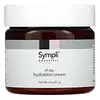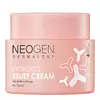What's inside
What's inside
 Key Ingredients
Key Ingredients

 Benefits
Benefits

 Concerns
Concerns

 Ingredients Side-by-side
Ingredients Side-by-side

Water
Skin ConditioningGlycerin
HumectantSqualane
EmollientButylene Glycol
HumectantTetradecane
PerfumingPolyacrylamide
Saccharide Isomerate
HumectantAcetyl Hexapeptide-37
Skin ConditioningSodium Hyaluronate
HumectantChamomilla Recutita Flower Extract
MaskingAloe Barbadensis Leaf Juice
Skin ConditioningPolyhydroxystearic Acid
EmulsifyingNiacinamide
SmoothingCalcium Pantothenate
Sodium Ascorbyl Phosphate
AntioxidantTocopheryl Acetate
AntioxidantPyridoxine Hcl
Skin ConditioningMaltodextrin
AbsorbentSodium Starch Octenylsuccinate
AbsorbentSilica
AbrasiveC13-14 Isoparaffin
EmollientLaureth-7
EmulsifyingPhenoxyethanol
PreservativeEthylhexylglycerin
Skin ConditioningPotassium Sorbate
PreservativeHydroxyethyl Acrylate/Sodium Acryloyldimethyl Taurate Copolymer
Emulsion StabilisingCitric Acid
BufferingSodium Citrate
BufferingTriisononanoin
Skin ConditioningParfum
MaskingCitral
PerfumingCitronellol
PerfumingHexyl Cinnamal
PerfumingLimonene
PerfumingLinalool
PerfumingWater, Glycerin, Squalane, Butylene Glycol, Tetradecane, Polyacrylamide, Saccharide Isomerate, Acetyl Hexapeptide-37, Sodium Hyaluronate, Chamomilla Recutita Flower Extract, Aloe Barbadensis Leaf Juice, Polyhydroxystearic Acid, Niacinamide, Calcium Pantothenate, Sodium Ascorbyl Phosphate, Tocopheryl Acetate, Pyridoxine Hcl, Maltodextrin, Sodium Starch Octenylsuccinate, Silica, C13-14 Isoparaffin, Laureth-7, Phenoxyethanol, Ethylhexylglycerin, Potassium Sorbate, Hydroxyethyl Acrylate/Sodium Acryloyldimethyl Taurate Copolymer, Citric Acid, Sodium Citrate, Triisononanoin, Parfum, Citral, Citronellol, Hexyl Cinnamal, Limonene, Linalool
Water
Skin ConditioningLactobacillus Ferment Lysate 14.3%
Skin ConditioningButylene Glycol
HumectantPropanediol
SolventIsopentyldiol
HumectantDimethicone
EmollientCyclopentasiloxane
EmollientGlycerin
HumectantNiacinamide
SmoothingHydrogenated Poly(C6-14 Olefin)
EmollientCyclohexasiloxane
Emollient1,2-Hexanediol
Skin ConditioningPEG-240/Hdi Copolymer Bis-Decyltetradeceth-20 Ether
StabilisingButyrospermum Parkii Butter
Skin ConditioningPolyglyceryl-10 Myristate
Skin ConditioningPolyglyceryl-2 Stearate
EmulsifyingHydroxyethyl Acrylate/Sodium Acryloyldimethyl Taurate Copolymer
Emulsion StabilisingGlyceryl Stearate
EmollientStearyl Alcohol
EmollientEthylhexylglycerin
Skin ConditioningAdenosine
Skin ConditioningBetaine
HumectantAllantoin
Skin ConditioningTrehalose
HumectantPanthenol
Skin ConditioningSodium PCA
HumectantBifida Ferment Lysate
Skin ConditioningSodium Lactate
BufferingGossypium Herbaceum Extract
Skin ConditioningArginine
MaskingAspartic Acid
MaskingPCA
HumectantStreptococcus Thermophilus Ferment
HumectantCaprylic/Capric Triglyceride
MaskingGlycine
BufferingAlanine
MaskingLecithin
EmollientRoyal Jelly Extract
Skin ConditioningMilk Extract
Skin ConditioningPolysorbate 20
EmulsifyingPropolis Extract
Skin ConditioningHydrolyzed Collagen
EmollientLactose
HumectantArtemisia Capillaris Extract
Simmondsia Chinensis Seed Oil
EmollientHelianthus Annuus Seed Oil
EmollientSerine
MaskingValine
MaskingIsoleucine
Skin ConditioningThreonine
Proline
Skin ConditioningPhenylalanine
MaskingHistidine
HumectantHyaluronic Acid
HumectantLupinus Albus Seed Extract
Skin ConditioningSodium Ascorbyl Phosphate
AntioxidantPhospholipids
Skin ConditioningPhytosphingosine
Skin ConditioningCopper Tripeptide-1
Skin ConditioningCeramide 3
Skin ConditioningLactic Acid
BufferingCholesterol
EmollientHydrolyzed Hyaluronic Acid
HumectantMadecassoside
AntioxidantTocopherol
AntioxidantSodium Hyaluronate
HumectantSqualane
EmollientTripeptide-1
Skin ConditioningPalmitoyl Tripeptide-1
Skin ConditioningTripeptide-2
Skin ConditioningHexapeptide-11
Skin ConditioningPhytosterols
Skin ConditioningDunaliella Salina Extract
Skin ConditioningAcetyl Hexapeptide-8
HumectantPalmitoyl Tetrapeptide-7
Skin ConditioningPalmitoyl Pentapeptide-4
Skin ConditioningHexapeptide-9
Skin ConditioningNonapeptide-1
Skin ConditioningDisodium EDTA
Parfum
MaskingWater, Lactobacillus Ferment Lysate 14.3%, Butylene Glycol, Propanediol, Isopentyldiol, Dimethicone, Cyclopentasiloxane, Glycerin, Niacinamide, Hydrogenated Poly(C6-14 Olefin), Cyclohexasiloxane, 1,2-Hexanediol, PEG-240/Hdi Copolymer Bis-Decyltetradeceth-20 Ether, Butyrospermum Parkii Butter, Polyglyceryl-10 Myristate, Polyglyceryl-2 Stearate, Hydroxyethyl Acrylate/Sodium Acryloyldimethyl Taurate Copolymer, Glyceryl Stearate, Stearyl Alcohol, Ethylhexylglycerin, Adenosine, Betaine, Allantoin, Trehalose, Panthenol, Sodium PCA, Bifida Ferment Lysate, Sodium Lactate, Gossypium Herbaceum Extract, Arginine, Aspartic Acid, PCA, Streptococcus Thermophilus Ferment, Caprylic/Capric Triglyceride, Glycine, Alanine, Lecithin, Royal Jelly Extract, Milk Extract, Polysorbate 20, Propolis Extract, Hydrolyzed Collagen, Lactose, Artemisia Capillaris Extract, Simmondsia Chinensis Seed Oil, Helianthus Annuus Seed Oil, Serine, Valine, Isoleucine, Threonine, Proline, Phenylalanine, Histidine, Hyaluronic Acid, Lupinus Albus Seed Extract, Sodium Ascorbyl Phosphate, Phospholipids, Phytosphingosine, Copper Tripeptide-1, Ceramide 3, Lactic Acid, Cholesterol, Hydrolyzed Hyaluronic Acid, Madecassoside, Tocopherol, Sodium Hyaluronate, Squalane, Tripeptide-1, Palmitoyl Tripeptide-1, Tripeptide-2, Hexapeptide-11, Phytosterols, Dunaliella Salina Extract, Acetyl Hexapeptide-8, Palmitoyl Tetrapeptide-7, Palmitoyl Pentapeptide-4, Hexapeptide-9, Nonapeptide-1, Disodium EDTA, Parfum
 Reviews
Reviews

Ingredients Explained
These ingredients are found in both products.
Ingredients higher up in an ingredient list are typically present in a larger amount.
Butylene Glycol (or BG) is used within cosmetic products for a few different reasons:
Overall, Butylene Glycol is a safe and well-rounded ingredient that works well with other ingredients.
Though this ingredient works well with most skin types, some people with sensitive skin may experience a reaction such as allergic rashes, closed comedones, or itchiness.
Learn more about Butylene GlycolEthylhexylglycerin (we can't pronounce this either) is commonly used as a preservative and skin softener. It is derived from glyceryl.
You might see Ethylhexylglycerin often paired with other preservatives such as phenoxyethanol. Ethylhexylglycerin has been found to increase the effectiveness of these other preservatives.
Glycerin is already naturally found in your skin. It helps moisturize and protect your skin.
A study from 2016 found glycerin to be more effective as a humectant than AHAs and hyaluronic acid.
As a humectant, it helps the skin stay hydrated by pulling moisture to your skin. The low molecular weight of glycerin allows it to pull moisture into the deeper layers of your skin.
Hydrated skin improves your skin barrier; Your skin barrier helps protect against irritants and bacteria.
Glycerin has also been found to have antimicrobial and antiviral properties. Due to these properties, glycerin is often used in wound and burn treatments.
In cosmetics, glycerin is usually derived from plants such as soybean or palm. However, it can also be sourced from animals, such as tallow or animal fat.
This ingredient is organic, colorless, odorless, and non-toxic.
Glycerin is the name for this ingredient in American English. British English uses Glycerol/Glycerine.
Learn more about GlycerinThis is a synthetic polymer. It helps improve the texture of products by adding thickness and gel-like feel.
It is also an emulsifer, meaning it prevents ingredients such as oil and water from separating. It also helps evenly disperse other ingredients.
Niacinamide is a multitasking form of vitamin B3 that strengthens the skin barrier, reduces pores and dark spots, regulates oil, and improves signs of aging.
And the best part? It's gentle and well-tolerated by most skin types, including sensitive and reactive skin.
You might have heard of "niacin flush", or the reddening of skin that causes itchiness. Niacinamide has not been found to cause this.
In very rare cases, some individuals may not be able to tolerate niacinamide at all or experience an allergic reaction to it.
If you are experiencing flaking, irritation, and dryness with this ingredient, be sure to double check all your products as this ingredient can be found in all categories of skincare.
When incorporating niacinamide into your routine, look out for concentration amounts. Typically, 5% niacinamide provides benefits such as fading dark spots. However, if you have sensitive skin, it is better to begin with a smaller concentration.
When you apply niacinamide to your skin, your body converts it into nicotinamide adenine dinucleotide (NAD). NAD is an essential coenzyme that is already found in your cells as "fuel" and powers countless biological processes.
In your skin, NAD helps repair cell damage, produce new healthy cells, support collagen production, strengthen the skin barrier, and fight environmental stressors (like UV and pollution).
Our natural NAD levels start to decline with age, leading to slower skin repair, visible aging, and a weaker skin barrier. By providing your skin niacinamide, you're recharging your skin's NAD levels. This leads to stronger, healthier, and younger looking skin.
Another name for vitamin B3 is nicotinamide. This vitamin is water-soluble and our bodies don't store it. We obtain Vitamin B3 from either food or skincare. Meat, fish, wheat, yeast, and leafy greens contain vitamin B3.
The type of niacinamide used in skincare is synthetically created.
Learn more about NiacinamideParfum is a catch-all term for an ingredient or more that is used to give a scent to products.
Also called "fragrance", this ingredient can be a blend of hundreds of chemicals or plant oils. This means every product with "fragrance" or "parfum" in the ingredients list is a different mixture.
For instance, Habanolide is a proprietary trade name for a specific aroma chemical. When used as a fragrance ingredient in cosmetics, most aroma chemicals fall under the broad labeling category of “FRAGRANCE” or “PARFUM” according to EU and US regulations.
The term 'parfum' or 'fragrance' is not regulated in many countries. In many cases, it is up to the brand to define this term.
For instance, many brands choose to label themselves as "fragrance-free" because they are not using synthetic fragrances. However, their products may still contain ingredients such as essential oils that are considered a fragrance by INCI standards.
One example is Calendula flower extract. Calendula is an essential oil that still imparts a scent or 'fragrance'.
Depending on the blend, the ingredients in the mixture can cause allergies and sensitivities on the skin. Some ingredients that are known EU allergens include linalool and citronellol.
Parfum can also be used to mask or cover an unpleasant scent.
The bottom line is: not all fragrances/parfum/ingredients are created equally. If you are worried about fragrances, we recommend taking a closer look at an ingredient. And of course, we always recommend speaking with a professional.
Learn more about ParfumSodium Ascorbyl Phosphate is a form of Vitamin C. It is the salt of ascorbic acid.
This ingredient is more gentle than ascorbic acid. It is also more stable when exposed to light and oxygen.
Vitamin C helps reduce redness, improve skin texture, reduce the effects of aging, reduce the visibility of dark spots, and brighten skin.
Your skin uses Vitamin C to produce collagen and collagen production plays a role in having a strong skin barrier and plump skin. As an antioxidant, this ingredient also helps reduce the signs of aging such as fine-lines and wrinkles.
VItamin C helps brighten skin by blocking the process of skin darkening.
In a 2011 study, Sodium Ascorbyl Phosphate was found to have antibacterial properties. This may help treat acne.
Read more about other types of Vitamin C:
Learn more about Sodium Ascorbyl PhosphateSodium Hyaluronate is hyaluronic acid's salt form. It is commonly derived from the sodium salt of hyaluronic acid.
Like hyaluronic acid, it is great at holding water and acts as a humectant. This makes it a great skin hydrating ingredient.
Sodium Hyaluronate is naturally occurring in our bodies and is mostly found in eye fluid and joints.
These are some other common types of Hyaluronic Acid:
Learn more about Sodium HyaluronateSqualane is an emollient that helps the skin hold onto moisture. It's an oily liquid that occurs naturally in certain types of fish and plant oils.
Because squalane boosts hydration in the skin, it also comes with plenty of benefits: it is an antioxidant and can help fight free radicals and skin damage. Squalane is also found to have a detoxifying effect when applied.
Squalane comes from squalene, which occurs naturally within the sebum of our skin. It is one of the oils our skin produces to keep itself hydrated. Squalane is the hydrogenated version of squalene and has a longer shelf life.
Research shows that squalane is non-irritating (even at 100% concentration).
In general, it's a fantastic ingredient. It does a great job at hydrating the skin, and it's suitable for those with sensitive skin.
The source of squalane may impact malassezia / fungal acne. This is because olive oil derived squalane can contain impurities such as fatty acids and plant waxes. Sugarcane derived squalane is recommended for anyone with malassezia concerns.
Is squalane vegan?
This depends on the source. Squalane can be derived from both plants and animals. Most squalane used in skincare comes from plants.
Please note: the source of squalane is only known if disclosed by the brand. We recommend reaching out to the brand if you have any questions about their squalane.
Read more about squalene with an "e".
Is squalane an oil?
Squalane is often called an oil, but it’s technically not; it’s a hydrocarbon, meaning it’s only made of carbon and hydrogen, unlike true oils which are triglycerides made of fatty acids and glycerol.
The term “oil-free” isn’t regulated, so companies can define it however they want. Some exclude all oils, while others just avoid mineral oil or comedogenic oils.
While some people avoid oils thinking they cause breakouts, the right kind of oil (or oil-like ingredient like squalane) can actually help balance and hydrate your skin. It’s worth testing out simple oils or squalane to see what works best for your skin.
Learn more about SqualaneWater. It's the most common cosmetic ingredient of all. You'll usually see it at the top of ingredient lists, meaning that it makes up the largest part of the product.
So why is it so popular? Water most often acts as a solvent - this means that it helps dissolve other ingredients into the formulation.
You'll also recognize water as that liquid we all need to stay alive. If you see this, drink a glass of water. Stay hydrated!
Learn more about Water